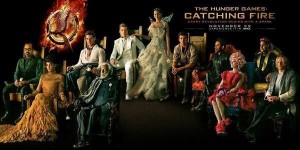The Hunger Games: Catching Fire
Posted on November 20, 2013 at 11:35 am
 In the second chapter of the three-book, four-movie series, Katniss Everdeen has gone from being a shy unknown with extraordinary skills to being an acclaimed superstar. The same could be said for the actress who plays the part. When Jennifer Lawrence was selected to play the heroine of the blockbuster novels by Suzanne Collins
In the second chapter of the three-book, four-movie series, Katniss Everdeen has gone from being a shy unknown with extraordinary skills to being an acclaimed superstar. The same could be said for the actress who plays the part. When Jennifer Lawrence was selected to play the heroine of the blockbuster novels by Suzanne Collins, she was barely out of her teens. She had scored an Oscar nomination for a small, independent film called Winter’s Bone
that was seen by about the number of people listed in the credits of this film. And in between the first and second in the “Hunger Games” series, she won a leading actress Oscar for Silver Linings Playbook
.
In this deeper, smarter, politically sharper, and more emotionally resonant follow-up, she returns to the dystopian world of Panem as Katniss prepares for her victory tour, following an unprecedented triumph at the titular competition. Once a year, two teenagers are selected from each of the twelve districts to compete to the death in televised combat that the totalitarian government imposes in a gruesome simulacrum of an athletic contest that promotes dedication, talent, and integrity. As the previous film ended, Katniss and Peeta (Josh Hutcherson) defied the authorities to come up with a way that they could both come out alive — by pretending to be in love and be willing to sacrifice themselves to be together. This has made them very popular, and the dictator, “President” Snow (a nicely corrupt Donald Sutherland) wants to make sure that this popularity is extended on behalf of his regime and will not inspire any rebellious uprisings. When his own granddaughter begins to braid her hair to be like Katniss, he knows that if he cannot control the young archer, he will have to destroy her. However, as the new Head Gamemaker, Plutarch Heavensbee (Philip Seymour Hoffman) reminds him, he must be careful to get rid of her in a way that will discredit her, to make sure she does not become a martyr and inspire the rebels even more in memory than she already does.
Snow tells Katniss she has to persuade not just the fans but him that she is truly in love with Peeta or he will destroy her and her family. She does her best, and cares for Peeta deeply, but her heart is still with Gale (Liam Hemsworth), who is hurt and jealous.
Plutarch decides to mount an all-star game, pitting previous champions of the Hunger Games against each other in a ramped-up competition. And no skirting the rules with a romance this time. Katniss and Peeta go back to the Capital for another dress-up extravaganza (costume designer Trish Summerville ramps things up with costumes that are a mash-up between “Project Runway’s” unconventional materials and fashion forward challenges and an acid trip. Elizabeth Banks carries off the wildest of the attire better than anyone else could (with the exception of Barbie), and manages to give the outrageous Effie Trinket a little bit of compassion under the Kabuki-like makeup. And Katniss, known as the “girl on fire” thanks to the costumes designed by the stylist Cinna (Lenny Kravitz) gets a wedding gown extravaganza with an unexpected political overlay.
And then, the games begin, as before, with the same race to get supplies and weapons while avoiding attack and assessing possible alliances that by definition will be short-term. Plutarch has some challenges of his own to keep the contestants off-balance and on the run. With each “tribute” a previous winner, the odds are not in anyone’s favor.
Director Francis Lawrence (“I am Legend,” no relation to his star), taking over from Gary Ross, manages the large cast and complicated action well and screenwriters Simon Beaufoy (“Salmon Fishing in the Yemen”) and Michael Arndt (“Toy Story III,” “Little Miss Sunshine”) adapted the book deftly. They balance the small, intimate moments, brief humor, and intense emotion with the grand sweep of the games, acknowledging the over-arching themes of honor, freedom, and courage but keeping the focus on the relationships. It tells us everything that in the short training/assessment/sponsorship-seeking period before the Games begin, Katniss reaches out to the weakest and most vulnerable of the other contestants, helping them with no agenda for her own protection.
The other additions to the series are exceptionally well-chosen, too, especially Hoffman, as a man who knows more about “counter-moves” than we may suspect at first, Sam Claflin as the high-spirited, faun-like Finnick Odair, Jeffrey Wright and Amanda Plummer as the wonkiest participants, and Jena Malone, a fiery delight as the furious Johanna Mason. But it is Lawrence who steals the show again as Katniss. Be sure to keep your eyes on her face in that last scene; it’s a lulu that will have you counting the moments until the next episode (now in production).
Parents should know that the theme of these books concerns a totalitarian dictatorship that forces teenagers to battle to the death in a very intense and disturbing “game.” Many characters are injured and killed and there are scary surprises, graphic images, and disturbing threats. Many teenage and adult characters are beaten, injured, and killed, with knives, guns, whips, arrows, spears, poison fog, animal attacks, psychological abuse, and more. Characters abuse alcohol, there are drug references, and characters use some strong language. There is kissing and some implied nudity in public — nothing shown.
Family discussion: What did Plutarch mean by “moves and countermoves?” Why did the tributes hold hands? Why wouldn’t Gale leave?
If you like this, try: the first movie and the books by Suzanne Collins


